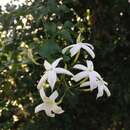pt-BR
nomes no trilho de navegação


Jasminum tortuosum is a species of jasmine native to South Africa.[2] It is generally found twining high into the trees of forests in southwestern part of Cape Province, but also may scramble where there is little vertical space. It has angular branches off its main stem, and its flowers usually have five white petals each.[3] The specific epithet (tortuosum) is from Latin, describing something that is winding or very twisted.[5]
'Jasminum' is a Latinized form of the Arabic word, 'yasemin' for sweetly scented plants.[6]
'Tortuosum' is the possessive form os 'tortus', meaning 'complex', 'meandering', or 'winding'; this is a reference to the twining of its stems.[6]
J. tortuosum growing in Huntington Desert Garden in California
Jasminum tortuosum is a species of jasmine native to South Africa. It is generally found twining high into the trees of forests in southwestern part of Cape Province, but also may scramble where there is little vertical space. It has angular branches off its main stem, and its flowers usually have five white petals each. The specific epithet (tortuosum) is from Latin, describing something that is winding or very twisted.
Jasminum tortuosum es una especie de arbusto de la familia de las oleáceas. Es nativo de Sudáfrica.[2]
Tiene ramas angulosas en su tallo principal, y sus flores generalmente tienen cinco pétalos blancos cada una.
Se encuentra generalmente en alto en los árboles en los bosques en la parte sudoeste de la provincia del Cabo, pero también puede trepar donde hay poco espacio vertical.
Jasminum tortuosum fue descrita por Carl Ludwig von Willdenow y publicado en Enumeratio Plantarum Horti Botanici Berolinensis, . . . 1: 10. 1809.[3]
Jasminum: nombre latino de estas plantas. Podría derivar del persa yasamin o del árabe yasmin.[4]
tortuosum: epíteto latino que significa "retorcido".[5][6]
Jasminum tortuosum es una especie de arbusto de la familia de las oleáceas. Es nativo de Sudáfrica.